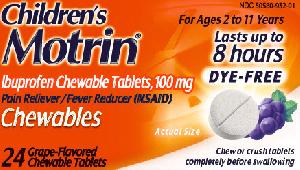Motrin Childrens Interactions
There are 423 drugs known to interact with Motrin Childrens (ibuprofen), along with 11 disease interactions, and 2 alcohol/food interactions. Of the total drug interactions, 101 are major, 306 are moderate, and 16 are minor.
- View all 423 medications that may interact with Motrin Childrens
- View Motrin Childrens alcohol/food interactions (2)
- View Motrin Childrens disease interactions (11)
Most frequently checked interactions
View interaction reports for Motrin Childrens (ibuprofen) and the medicines listed below.
- acetaminophen
- albuterol
- amoxicillin
- azithromycin
- baclofen
- Bactroban (mupirocin topical)
- Benadryl (diphenhydramine)
- Benadryl Allergy (diphenhydramine)
- Calmoseptine (menthol/zinc oxide topical)
- cetirizine
- Children's Tylenol (acetaminophen)
- Claritin (loratadine)
- clonazepam
- clonidine
- diazepam
- Flonase (fluticasone nasal)
- guaifenesin
- Keppra (levetiracetam)
- loratadine
- melatonin
- MiraLAX (polyethylene glycol 3350)
- mupirocin topical
- Nexium (esomeprazole)
- nystatin topical
- oxygen
- prednisolone
- Tylenol (acetaminophen)
- Vitamin D3 (cholecalciferol)
- Zantac (ranitidine)
- Zyrtec (cetirizine)
Motrin Childrens alcohol/food interactions
There are 2 alcohol/food interactions with Motrin Childrens (ibuprofen).
Motrin Childrens disease interactions
There are 11 disease interactions with Motrin Childrens (ibuprofen) which include:
- asthma
- fluid retention
- GI toxicity
- rash
- renal toxicities
- thrombosis
- PKU
- anemia
- hepatotoxicity
- hyperkalemia
- platelet aggregation inhibition
More about Motrin Childrens (ibuprofen)
- Motrin Childrens consumer information
- Compare alternatives
- Pricing & coupons
- Drug images
- Latest FDA alerts (15)
- Side effects
- Dosage information
- During pregnancy
- Drug class: Nonsteroidal anti-inflammatory drugs
- Breastfeeding
- En español
Related treatment guides
Drug Interaction Classification
| Highly clinically significant. Avoid combinations; the risk of the interaction outweighs the benefit. | |
| Moderately clinically significant. Usually avoid combinations; use it only under special circumstances. | |
| Minimally clinically significant. Minimize risk; assess risk and consider an alternative drug, take steps to circumvent the interaction risk and/or institute a monitoring plan. | |
| No interaction information available. |
See also:
Further information
Always consult your healthcare provider to ensure the information displayed on this page applies to your personal circumstances.


